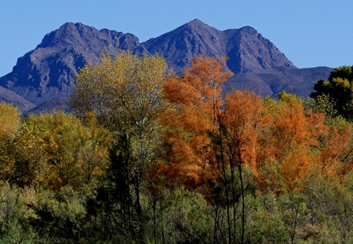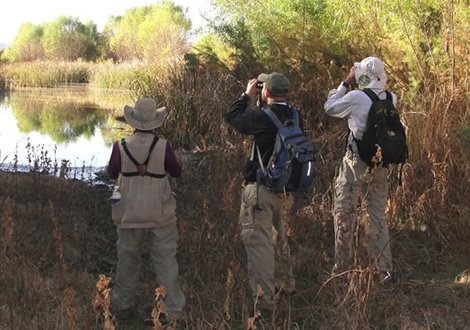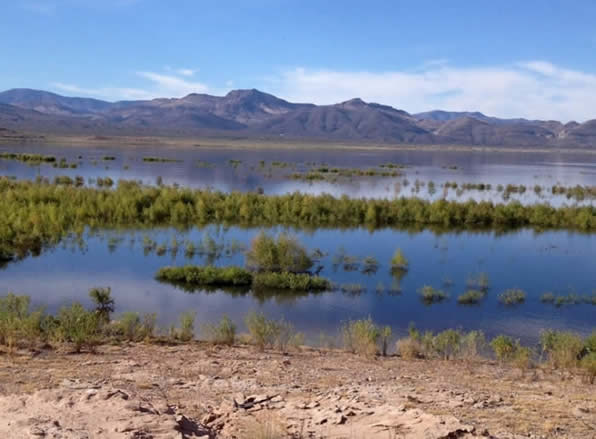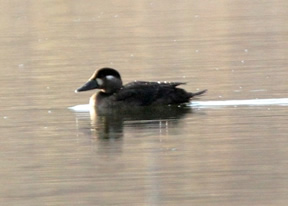 |
 |
|||||||||||||||||||||
|
||||||||||||||||||||||
AZFO FIELD EXPEDITION
San Carlos River and San Carlos Lake
Nov. 9-10
Doug Jenness
 |
| Riparian habitat along San Carlos R. Photo: Muriel Neddermeyer |
On 9-10 November nine participants conducted surveys on the lower San Carlos River and San Carlos Lake. Both are located on the San Carlos Apache tribal lands, which we accessed by obtaining day permits. The main goal of the expedition was to learn more about the vast riparian area along the lower San Carlos River. Previously, there were only a handful of reports from this area and all of them were in the spring. We were looking for three things: fall migrants, wintering birds from the north and higher elevations, and abundance of resident birds. Both days were clear and sunny with temperatures ranging from about 60° to 80°F.
San Carlos River
On Saturday, 9 November we divided into two teams and covered much of the area from the mouth of the river at San Carlos Lake to a point 4 miles north. The elevation of this area is about 2500 ft. The river serves as the boundary between Gila and Graham counties, with Gila to the west and Graham to the east. One team covered the northern tract (Tract 1), which was accessed from a point where the river comes close to IR15, and is 1.2 miles south of US Highway 70 in the town of Peridot. At this point the river corridor is about .25 miles across, and the team traveled a loop east across the river, downstream for 1.5 miles, across to the west side, and then back upstream for a total of 5.0 miles. The survey time was 6.25 hours. This area is vegetated by many large Fremont cottonwoods, Gooding's willows, velvet mesquite, and tamarisk. The team discovered a narrow stream of running water along the far eastern side of the corridor. The 29 species detected are tallied in Table 1.
The second team started at the mouth of the river and worked its way north along the western side of the corridor for 2.0 miles, then crossed the river, and headed down the eastern side for about 2.5 miles and then northwest back to its starting point. This loop (Tract 2) of approximately 6 miles was covered in 8.5 hours. Unlike, Tract 1, this area had few cottonwoods; it was dominated by large groves of willows and tamarisk. There were also vast areas without trees that were covered by scores of acres of cockleburs, camphorweed, or short grass. Some of the open areas also had scattered seep willows. Along the southwestern part of the loop the team found some large ponds of still water surrounded by cattails. There was also water along the southeastern edge of the tract, which appeared to be long narrow inlets from the lake. The 44 species detected are recorded in Table 1. The cattail habitat produced many Marsh Wrens, Song Sparrows, and 2 Soras. The willow groves had Northern Flickers and Red-naped Sapsuckers. In one grove of tall willows a mixed flock of passerines was found that included a Mountain Chickadee, a Dusky Flycatcher, and two Brown Creepers, along with the more numerous Ruby-crowned Kinglets and Yellow-rumped Warblers. Some of the edges between the willows and the cocklebur fields had a fair number of House Wrens along with a few Abert's and Green-tailed Towhees. Interestingly, three species of owls were detected: 1 Western Screech-Owl, 1 Barn Owl, and 1 Great-horned Owl. The most common raptor in this tract was Northern Harrier.
 |
 |
Mountain Chickadee, lower San Carlos R Photo: Brian Ison |
Pond with cattails attracts Sora, Marsh Wren Photo: Doug Jenness |
Both teams found colonies of stick nests in trees suggesting rookeries of some kind. Although Great Blue Herons are known to nest in the area, the nests seemed to be too small and may have been cormorant nests. In years when there has been more water along the river, especially near the mouth, islands of trees have been created with nesting cormorants. For example, in the spring of 2008 and 2010 several dozen active Double-crested Cormorant nests were observed near the mouth of the river. In most areas the teams were able to find cow trails to make their way, although in a few memorable instances they had to bushwhack through fields of burs and weeds five to seven feet high.
Our survey detected 54 avian species and confirmed that this riparian area is an attractive location for many wintering and resident birds, including a few high-elevation birds that come into the lowlands some winters, such as Mountain Chickadee and Brown Creeper. Another expedition in May or June would be useful to determine the birds that breed in this area.
San Carlos Lake
On Sunday 10 November, two teams surveyed San Carlos Lake--one along the north side and one along the south shore. For the past 10 years San Carlos Lake has been birded irregularly, typically five or six times a year. Prior to 2003, the reporting was even scantier. This reservoir, created by the construction of the Coolidge Dam across the Gila River, is one of the largest lakes in Arizona with a basin that is nearly 10 miles long. However, the water level can vary a lot, becoming nearly empty some times and much fuller at others. These fluctuations affect the number and diversity of birds that can be found there. If the lake has a lot of water there are fewer mudflats for migrating shorebirds; when it dries up there is a massive die-off of fish, reducing the number of fish-eating birds such as cormorants, grebes, and pelicans. In the past 10 years there have been summers when the conditions were suitable for Aechmophorous grebes to breed and downy young have been observed. Our survey was conducted at a time when the lake level had been one of its lowest--below 1 % capacity--but had very recently filled to about 14 % capacity. Fish restocking is only beginning so there are still not many fish, and there is little shorebird habitat. It may be why our count of Western and Clark's grebes and American White Pelicans was lower than typical for this time of year. However, we did have a wide assortment and good numbers of ducks.
 |
| East end of San Carlos L. looking south. Mt. Turnbull in background. Photo: Gordon Karre |
One would expect that such a vast water area would attract interesting transients, and in the past 10 years some notable rarities have been detected. They include: Arctic Tern, Laughing Gull, Surf Scoter, Little Blue Heron, Red Phalarope, Snowy Plover, Tundra Swan, and Rough-legged Hawk. Our survey added White-winged Scoter and another Laughing Gull to this list. The gull was a second record for both Pinal and Graham counties.
Two adult Bald Eagles were spotted from the south side of the lake, as well as two adults the day before several miles upstream on the San Carlos River. The Arizona Game and Fish Department, which conducts annual Bald Eagle surveys throughout the state, reports that currently there are four nesting sites in the area--one on the San Carlos River, one on the Gila River below the dam, and two around the lake. Unfortunately, the nest below the dam has failed the past several years.
In our survey of the lake, 70 species were recorded. The total for each species, except those with very few numbers, can only be estimated as both teams were often viewing some of the same flocks. Table 2, however, gives a sense of the totals observed. Waterfowl were most numerous, especially ducks, with Ruddy Duck, Lesser Scaup, and Green-winged Teal each numbering more than 1,000. Five white geese were a nice find, but considerably lower than many years for geese this season. Gull numbers were also lower than is typical in late fall and winter. The lake is bordered by three counties--Pinal, Gila, and Graham. However, for getting an overview of the avian population in this location, the totals for the entire lake are what are important.
Waste Water Ponds
Following the completion of its survey of the river, the north sector team checked out the waste water ponds along IR500 about 2.0 miles south of Peridot late Saturday afternoon. Two are along the road and have been checked irregularly by birders for the past decade, but three others are farther back and had not been previously noticed by birders.
 |
Surf Scoter at waste water ponds Photo: Muriel Neddermeyer |
Accessible by an ungated road, they are less choked with vegetation and offer better viewing. The highlight was a Surf Scoter, which continued for a second scoping of the ponds on Sunday morning. There was a nice selection of ducks, including Buffleheads, Lesser Scaups, and a Blue-winged Teal. A Pectoral Sandpiper was among the 15 or so Least Sandpipers. Three Barn Swallows were casual in mid-November. A total of 38 species was detected for the two visits; the tallies for each day are in Table 3. Along IR500 between Peridot and Coolidge Dam a few species, not observed elsewhere, included a Prairie Falcon, 5 Greater Roadrunners, and 11 European Starlings.
A special appreciation is extended to the participants: Babs Buck, Eric Hough, Brian Ison, Doug Jenness, Gordon Karre, Sue Kozacek, Muriel Neddermeyer, Nancy Rivera, and Marceline VandeWater.
Table 1. San Carlos River Survey, 9 Nov |
Table 2. San Carlos Lake Survey, 10 Nov |
Table 3. San Carlos Waste Water Ponds |
||||||||||
|---|---|---|---|---|---|---|---|---|---|---|---|---|
So. Loop |
No. Loop |
Total |
S. side |
N. side |
Total |
9-Nov |
10-Nov |
|||||
| Total numbers |
880 |
248 |
1128 |
Total numbers |
6949 | 996 | * | Total numbers |
78
|
140
|
||
| Total species | 44 |
30 |
54 |
Total species | 56 |
46 |
70 |
Total species | 29 |
33 |
||
| Hours | 8.5 |
6.25 |
14.8 |
Hours | 6 |
6 |
12 |
Observers | 5 |
9 |
||
| Miles | 6 |
3.5 |
9.5 |
Miles | 5 |
5 |
10 |
|||||
| Observers | 4 |
5 |
9 |
Observers | 3 |
6 |
9 |
|||||
Species |
Species |
Species | ||||||||||
| Mallard | 2 |
2 |
Snow Goose | 3 |
Gadwall | 1 |
||||||
| Gambel's Quail | 4 |
48 |
52 |
Ross's Goose | 2 |
American Wigeon | 1 |
|||||
| Great Blue Heron | 2 |
2 |
Gadwall | 475 |
110 |
Mallard (2 Mexican) | 4 |
|||||
| Bald Eagle | 2 |
2 |
American Wigeon | 169 |
100 |
Blue-winged Teal | 1 |
|||||
| Northern Harrier | 11 |
11 |
Mallard | 6 |
Northern Shoveler | 4 |
2 |
|||||
| Cooper's Hawk | 2 |
4 |
6 |
Northern Shoveler | 2 |
75 |
Green-winged Teal | 8 |
12 |
|||
| Red-tailed Hawk | 3 |
6 |
9 |
Northern Pintail | 3 |
3 |
Ring-necked Duck | 4 |
11 |
|||
| Sora | 2 |
2 |
Green-winged Teal | 1109 |
110 |
Lesser Scaup | 10 |
11 |
||||
| American Coot | 7 |
7 |
Redhead | 3 |
Surf Scoter | 1 |
1 |
|||||
| Killdeer | 8 |
8 |
Ring-necked Duck | 2 |
Bufflehead | 3 |
9 |
|||||
| Wilson's Snipe | 1 |
1 |
Lesser Scaup | 1156 |
20 |
Ruddy Duck | 2 |
1 |
||||
| Mourning Dove | 1 |
1 |
White-winged Scoter | 1 |
Gambel's Quail | 2 |
||||||
| Common Ground-Dove | 2 |
2 |
Bufflehead | 15 |
2 |
Pied-billed Grebe | 2 |
1 |
||||
| Barn Owl | 1 |
1 |
Ruddy Duck | 1500 |
160 |
Great Blue Heron | 1 |
|||||
| Western Screech-Owl | 1 |
1 |
Gambel's Quail | 17 |
2 |
Northern Harrier | 1 |
|||||
| Great Horned Owl | 1 |
1 |
Pied-billed Grebe | 1 |
3 |
Red-tailed Hawk | 1 |
|||||
| belted Kingfisher | 1 |
1 |
Eared Grebe | 72 |
26 |
Sora | 3 |
|||||
| Gila Woodpecker | 2 |
6 |
8 |
Western Grebe | 110 |
4 |
Common Gallinule | 2 |
||||
| Red-naped Sapsucker | 10 |
8 |
18 |
Clark's Grebe | 50 |
3 |
American Coot | 2 |
7 |
|||
| Ladder-backed Woodpecker | 2 |
9 |
11 |
Double-crested Cormorant | 12 |
2 |
Killdeer | 1 |
3 |
|||
| Northern Flicker | 8 |
4 |
12 |
American White Pelican | 20 |
5 |
Spotted Sandpiper | 5 |
||||
| American Kestrel | 2 |
2 |
Great Blue Heron | 13 |
2 |
Least Sandpiper | 1 |
17 |
||||
| Dusky Flycatcher | 1 |
1 |
Great Egret | 4 |
Pectoral Sandpiper | 1 |
||||||
| Black Phoebe | 4 |
3 |
7 |
Snowy Egret | 1 |
Ladder-backed Woodpecker | 1 |
|||||
| Say's Phoebe | 5 |
1 |
6 |
Bald Eagle | 2 |
Northern Flicker | 1 |
2 |
||||
| Loggerhead Shrike | 7 |
7 |
Northern Harrier | 4 |
1 |
Black Phoebe | 1 |
1 |
||||
| Common Raven | 21 |
20 |
41 |
Sharp-shinned Hawk | 1 |
Vermillion Flycatcher | 2 |
|||||
| Mountain Chickadee | 1 |
1 |
Red-tailed Hawk | 3 |
Say's Phoebe | 1 |
1 |
|||||
| Verdin | 7 |
7 |
Sora | 1 |
Loggerhead Shrike | 1 |
1 |
|||||
| White-breasted Nuthatch | 3 |
3 |
American Coot | 1890 |
290 |
Common Raven | 2 |
7 |
||||
| Brown Creeper | 2 |
2 |
Spotted Sandpiper | 3 |
1 |
Barn Swallow | 3 |
3 |
||||
| Rock Wren | 3 |
3 |
Greater Yellowlegs | 9 |
2 |
Marsh Wren | 1 |
1 |
||||
| House Wren | 16 |
16 |
Long-billed Dowitcher | 1 |
Bewick's Wren | 1 |
1 |
|||||
| Marsh Wren | 18 |
2 |
20 |
Laughing Gull | 1 |
American Pipit | 2 |
|||||
| Bewick's Wren | 14 |
2 |
16 |
Ring-billed Gull | 9 |
4 |
Phainopepla | 5 |
5 |
|||
| Black-tailed Gnatcatcher | 1 |
2 |
3 |
White-winged Dove | 1 |
3 |
Yellow-rumped Warbler | 6 |
1 |
|||
| Ruby-crowned Kinlet | 49 |
28 |
77 |
Great Horned Owl | 1 |
Song Sparrow | 1 |
|||||
| Western Bluebird | 12 |
12 |
White-throated Swift | 4 |
White-crowned Sparrow | 3 |
25 |
|||||
| Hermit Thrush | 1 |
1 |
Anna's Hummingbird | 1 |
Western Meadowlark | 2 |
1 |
|||||
| American Pipit | 1 |
1 |
2 |
Belted Kingfisher | 1 |
|||||||
| Orange-crowned Warbler | 2 |
2 |
Gila Woodpecker | 1 |
||||||||
| Common Yellowthroat | 3 |
3 |
Ladder-backed Woodpecker | 3 |
||||||||
| Yellow-rumped Warbler | 95 |
33 |
128 |
flicker sp. (Northern/Gilded) | 2 |
|||||||
| Northern Cardinal | 3 |
3 |
American Kestrel | 2 |
||||||||
| Green-tailed Towhee | 2 |
2 |
Merlin | 2 |
||||||||
| Abert's Towhee | 11 |
15 |
26 |
Black Phoebe | 1 |
|||||||
| Chipping Sparrow | 1 |
1 |
Say's Phoebe | 1 |
1 |
|||||||
| Song Sparrow | 88 |
7 |
95 |
Loggerhead Shrike | 4 |
4 |
||||||
| Lincoln Sparrow | 1 |
1 |
2 |
Common Raven | 5 |
14 |
||||||
| White-crowned Sparrow | 95 |
9 |
104 |
Verdin | 3 |
|||||||
| Red-winged Blackbird | 341 |
341 |
Rock Wren | 22 |
2 |
|||||||
| Western Meadowlark | 25 |
25 |
Canyon Wren | 7 |
||||||||
| House Finch | 10 |
10 |
Bewick's Wren | 1 |
||||||||
| Lesser Goldfinch | 1 |
1 |
Cactus Wren | 2 |
||||||||
| Black-tailed Gnatcatcher | 2 |
|||||||||||
| Ruby-crowned Kinglet | 1 |
|||||||||||
| American Robin | 1 |
|||||||||||
| Curve-billed Thrasher | 1 |
|||||||||||
| Crissal Thrasher | 2 |
1 |
||||||||||
| American Pipit | 9 |
3 |
||||||||||
| Phainopepla | 2 |
|||||||||||
| Yellow-rumped Warbler | 6 |
4 |
||||||||||
| Rufous-crowned Sparrow | 1 |
|||||||||||
| Canyon Towhee | 3 |
|||||||||||
| Black-throated Sparrow | 4 |
6 |
||||||||||
| Song Sparrow | 1 |
1 |
||||||||||
| White-crowned Sparrow | 2 |
|||||||||||
| Red-winged Blackbird | 200 |
7 |
||||||||||
| Western Meadowlark | 4 |
|||||||||||
| House Finch | 1 |
|||||||||||
| * Due to overlap between sightings from the north and south sides, difficult to determine total numbers | ||||||||||||
|
©2010 |
HOME | | | REPORT SIGHTINGS | | | PHOTOS | | | BIRDING | | | JOURNAL | | | ABOUT US | | | CHECKLISTS | | | AZ BIRD COMMITTEE | | | EVENTS | | | LINKS |